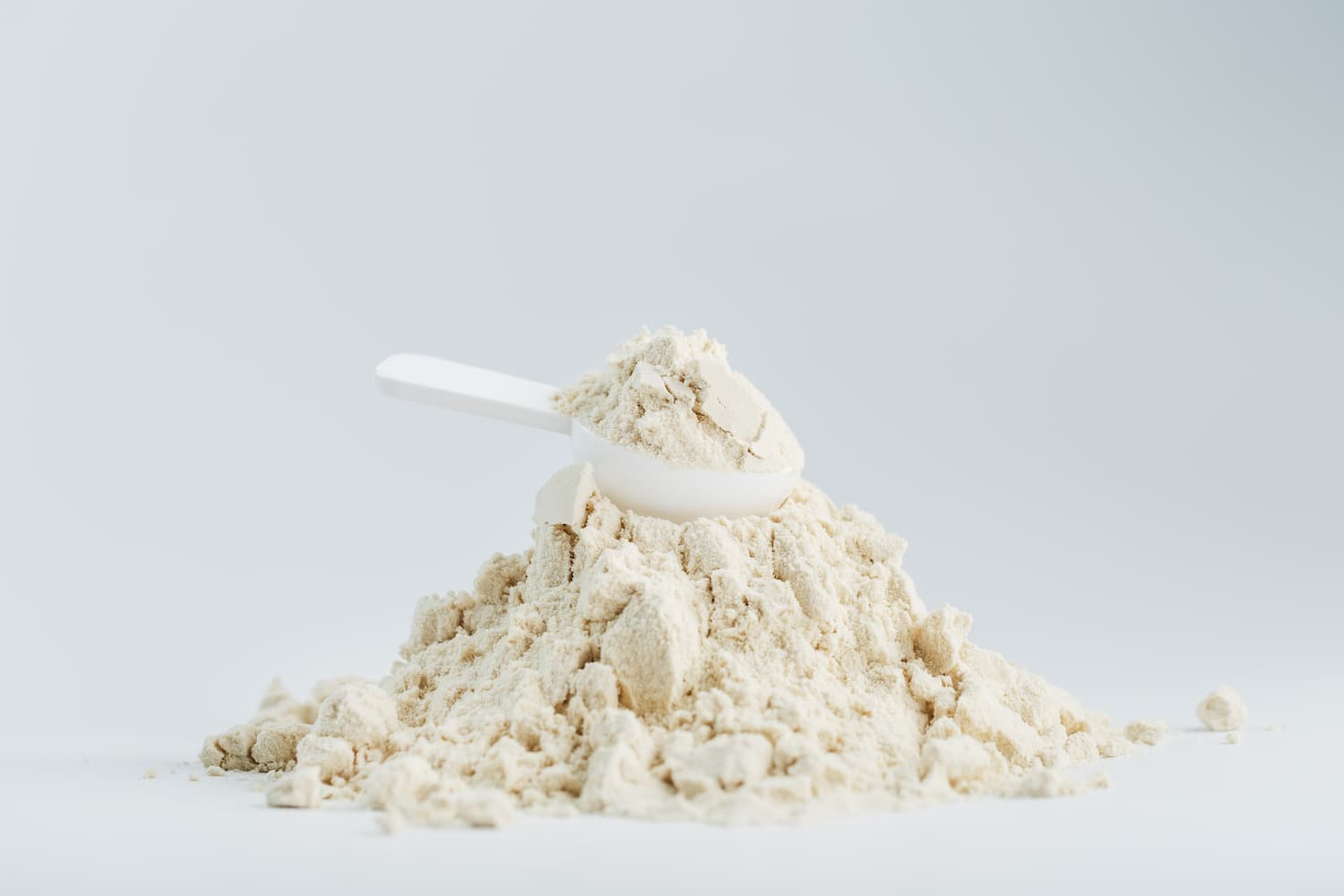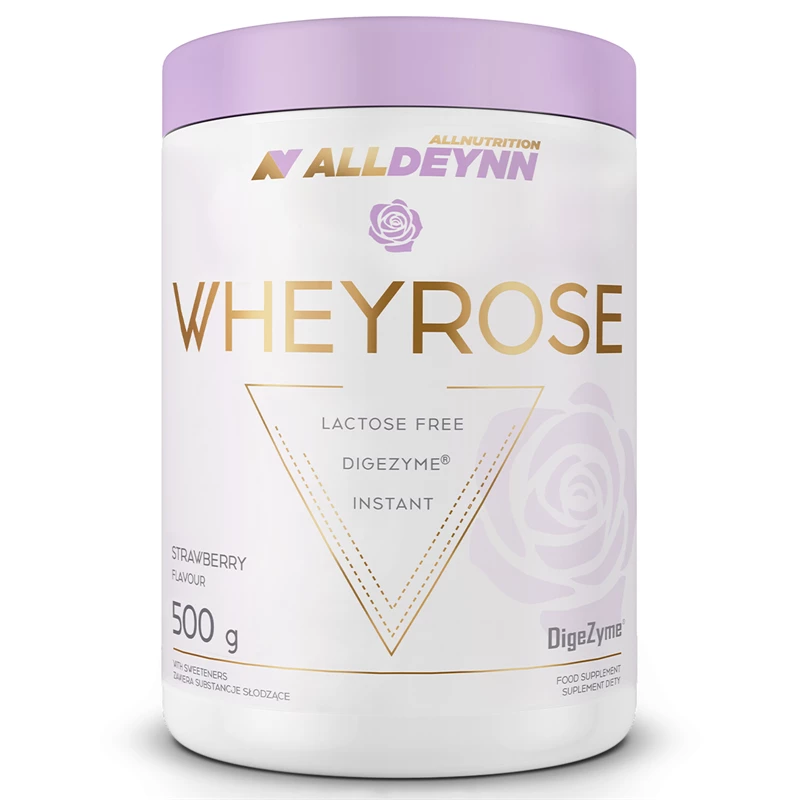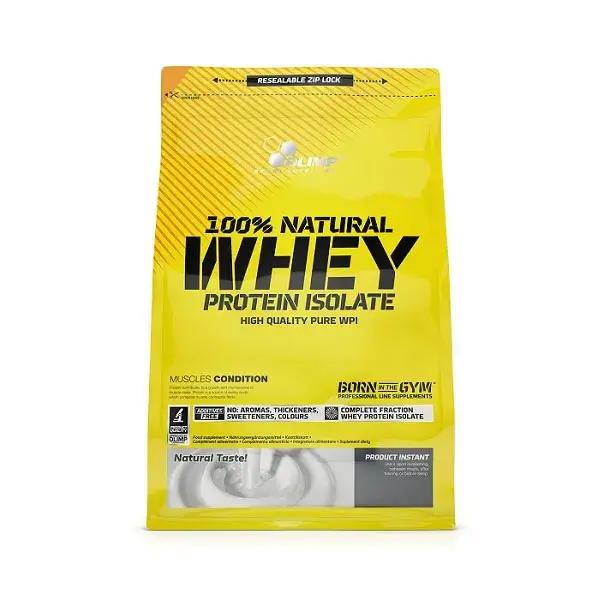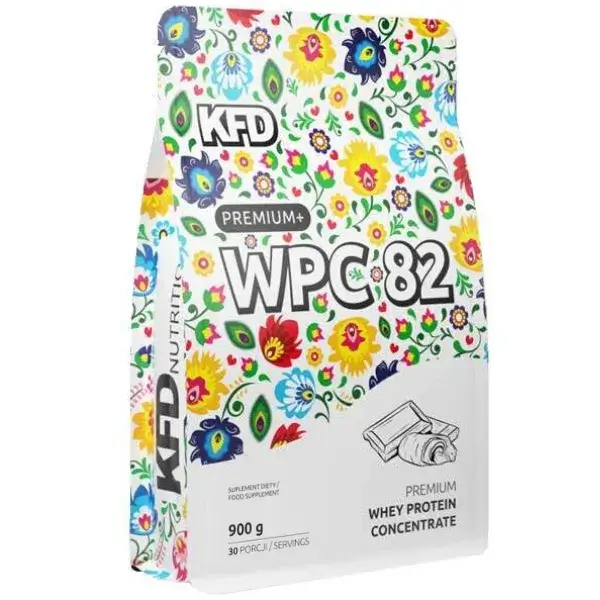Whey protein hydrolysate (WPH) - what is it and is it worth it?
WPH protein supplements are the purest protein. Find out if they are worth paying extra for.


Learn more about our editorial process
.

Learn more about our editorial process
.

Learn more about our editorial process
.

Learn more about our editorial process
.
Why you can trust us
Articles on Natu.Care are written based on scientific research, data from government websites and other reliable sources. The texts are written in cooperation with doctors, nutritionists and other health and beauty experts. Articles are reviewed before publication and during significant updates.
.Learn more about our editorial process
.Information about advertisements
Content on Natu.Care may contain links to products from the sale of which we may receive a commission. When creating content, we adhere to high editorial standards and take care to be objective about the products discussed. The presence of affiliate links is not dictated by our partners, and we select the products we review ourselves completely independently.
.Learn more about our terms and Conditions
.Whey protein hydrolysate (WPH) is the purest protein you can buy. It is absorbed in as little as 15 minutes and takes quickly for recovery and muscle growth after training. Unfortunately, it also makes your wallet clean just as quickly.
With dietician Kuba Pągowski, we will tell you who WPH is for, whether it is worth paying extra for it and what connects cokeheads from the gym with... beavers.
From this article you will learn:
.- What is WPH. .
- How whey protein hydrolysate is made. .
- What properties it has. .
- Is WPH only for professional bodybuilders. .
- What are the advantages and disadvantages of WPH. .
See also:
.- How much protein a day? .
- Isolate protein
- Protein concentrate
- Vegetable protein
- Casein
- Creatine
- Citrulline
- Creatine
- BCAA
- Citrulline
Protein in the body
.Protein is one of the three most important macronutrients in the diet, along with carbohydrates and fats. Protein in your bodyand:
- Serve as the building blocks for, among other things, hair, bone and muscle, .
- promote tissue growth and repair, .
- are involved in the production of enzymes and hormones, .
- strengthen the immune system, .
- regulate metabolic processes (e.g. digestion), .
- transport various components in the body (e.g. oxygen to cells), .
- are a source of energy, .
The average adult of normal body weight needs approximately 0.8-1 g protein per kilogram of body weight. People who are physically active and building muscle mass need up to 1.6-2.2 g per kilogram of body weightand.
In athletes protein requirements are high, but it doesn't always go well from meals. Protein supplements made from whey protein come to the rescue.
Whey protein - what is it?
.It is a mixture of proteins that have been isolated from whey - the liquid part of milkand during the production of cheese (or yoghurt). According to scientific studies, the consumption of whey protein stimulates the formation of dry muscle mass better than other protein sources such as plant-based .
Protein is highly nutritious, rich in essential amino acids - including BCAAs, making it a complete protein..
 .
.
Kuba Pągowski clinical dietitian
Whey protein types
.There are three types of whey protein with different protein contentand.
. .|
Type . |
% protein content per 100 g dry weight |
|
|
WPC - whey protein concentrate |
30-82% |
|
|
WPI - whey protein isolates |
90-95% | |
|
WPH - whey protein hydrolysate |
90-100% |
Whey proteins differ from one another:
- degree of processing,
- content of protein, fats and carbohydrates, .
- price, .
- amino acids, .
- B vitamins, .
- elements - magnesium, potassium, iron, calcium, phosphorus, .
- multi-unsaturated fatty acids, .
- soy isoflavones, .
- provides the body with protein quickly and effectively, .
- supports the building of muscle mass, .
- supports post-workout recovery,
- reduces the loss of muscle mass,
- protects the body's own protein intake
- reduces loss of muscle mass during a weight-loss diet,
- increases the thermogenic effect of food - raises metabolism, .
- helps transport nutrients, .
- influences the regulation of hormones, enzymes and antibodies, .
- provides the body with more amino acids, which improves nitrogen balance - extremely important for building muscle.
- High protein content (90-100% in 100 g).
- High protein content (90-100% in 100 g).
- Swallows in as little as 15 minutes.
- High protein content.
- Contains no lactose, so will work well for people with lactose intolerance.
- Provides amino acids and amino acids.
- Provides essential amino acids that the body does not produce, so you need to take them in with food.
- Provides a high level of essential amino acids that the body does not produce, so you need to take them in with food.
- High solubility. .
- Recommended for people on restrictive diets (e.g. ketogenic diet, food allergies).
- High price, averaging £14/100g. .
- Not suitable as a stand-alone meal. .
- Least palatable of the whey proteins.
- Low price.
- is assimilated more quickly - even 15 minutes after consumption,
- contains 90-100% of the protein in the body.
- contains 90-100% protein (WPC up to 80%, WPI up to 95%),
- contains no lactose.
- contains no lactose and is safe for people with lactose intolerance, .
- increases insulin production to the highest degree, affecting anabolism and energy storageand. .
- WPC and WPI will also provide you with protein, .
- the speed of uptake is not crucial in building muscle mass, .
- WPC uptake is not a palate delight, .
- you are lactose intolerant, .
- you have a sensitive stomach, .
- you are on a diet low-carbohydrate or ketogenic.
- weakly absorbs liquids, .
- is not suitable for baking, .
- is very sticky, .
- sensitivity to any component of the protein nutrient, .
- allergies to cow's milk proteins, .
- acne and other skin problems, .
- abdominal pain, .
- diarrhoea, .
- coughing, .
- gas, .
- WPH (pronounced Whey Protein Hydrolysate) is hydrolysed whey protein.
- Contains between 90 and 100% protein. .
- It is absorbed in 15-60 minutes and provides the body with protein quickly. .
- It is the purest form of whey protein. .
- Ideal for people with lactose intolerance and sensitive digestive systems. .
- WPH is the most expensive of all whey proteins. .
- Consuming WPH has no greater benefit in building muscle mass than WPC and WPI. .
- probably
What is hydrolysed protein?
.Hydrolysate is a protein obtained by the process of hydrolysis, which involves breaking down larger protein molecules into smaller ones (peptides) using enzymes. This makes hydrolysate quickly and efficiently absorbed into the bodyand.
The protein is then purified and dried into powder form. Then - depending on the manufacturer - flavourings or other ingredients are added, such as vitamins or minerals.
.There are several types of hydrolysed protein of animal or plant origin. The most popular is WPH.
ALLDEYNN WHEYROSE
Product description
Protein supplement containing whey protein concentrate (WPC) with added digestive enzymesós. It digests well, is an easy and quick way to provide protein and can be consumed by people with lactose intolerance. It will work well not only as a stand-alone drinkóy but also as a tasty addition to shakesóy, dessertsóy, oatmeal or omeletóy.
WHEYROSE contains five digestive enzymes that help break down macromolecules into smaller components, so that the ingredients from food and the nutrient are absorbed even better. This minimises or even eliminates digestive discomfort. Such an addition is rare in protein supplements.
.Pros and cons
Protein supplement containing whey protein concentrate (WPC) with added digestive enzymesós. It digests well, is an easy and quick way to provide protein and can be consumed by people with lactose intolerance. It will work well not only as a stand-alone drinkóy but also as a tasty addition to shakesóy, dessertsóy, oatmeal or omeletóy.
WHEYROSE contains five digestive enzymes that help break down macromolecules into smaller components, so that the ingredients from food and the nutrient are absorbed even better. This minimises or even eliminates digestive discomfort. Such an addition is rare in protein supplements.
.Additional information
Protein supplement containing whey protein concentrate (WPC) with added digestive enzymesós. It digests well, is an easy and quick way to provide protein and can be consumed by people with lactose intolerance. It will work well not only as a stand-alone drinkóy but also as a tasty addition to shakesóy, dessertsóy, oatmeal or omeletóy.
WHEYROSE contains five digestive enzymes that help break down macromolecules into smaller components, so that the ingredients from food and the nutrient are absorbed even better. This minimises or even eliminates digestive discomfort. Such an addition is rare in protein supplements.
.User review
Protein supplement containing whey protein concentrate (WPC) with added digestive enzymesós. It digests well, is an easy and quick way to provide protein and can be consumed by people with lactose intolerance. It will work well not only as a stand-alone drinkóy but also as a tasty addition to shakesóy, dessertsóy, oatmeal or omeletóy.
WHEYROSE contains five digestive enzymes that help break down macromolecules into smaller components, so that the ingredients from food and the nutrient are absorbed even better. This minimises or even eliminates digestive discomfort. Such an addition is rare in protein supplements.
.ALLDEYNN VEGEROSE
Product description
A protein supplement made from five plant proteins enriched with acacia fibre, flaxseed, MCT oil and the probiotic-prebiotic complex LactoWise®. It is a synbiotic thatós stimulates the developmentóy and growth of beneficial bacteria in the gastrointestinal tract and shows a beneficial effect on the condition of the digestive system.
Pros and cons
A protein supplement made from five plant proteins enriched with acacia fibre, flaxseed, MCT oil and the probiotic-prebiotic complex LactoWise®. It is a synbiotic thatós stimulates the developmentóy and growth of beneficial bacteria in the gastrointestinal tract and shows a beneficial effect on the condition of the digestive system.
Additional information
A protein supplement made from five plant proteins enriched with acacia fibre, flaxseed, MCT oil and the probiotic-prebiotic complex LactoWise®. It is a synbiotic thatós stimulates the developmentóy and growth of beneficial bacteria in the gastrointestinal tract and shows a beneficial effect on the condition of the digestive system.
Expert opinion
A protein supplement made from five plant proteins enriched with acacia fibre, flaxseed, MCT oil and the probiotic-prebiotic complex LactoWise®. It is a synbiotic thatós stimulates the developmentóy and growth of beneficial bacteria in the gastrointestinal tract and shows a beneficial effect on the condition of the digestive system.
ALLDEYNN VEGEROSE
Product description
A protein supplement made from five plant proteins enriched with acacia fibre, flaxseed, MCT oil and the probiotic-prebiotic complex LactoWise®. It is a synbiotic thatós stimulates the developmentóy and growth of beneficial bacteria in the gastrointestinal tract and shows a beneficial effect on the condition of the digestive system.
Pros and cons
A protein supplement made from five plant proteins enriched with acacia fibre, flaxseed, MCT oil and the probiotic-prebiotic complex LactoWise®. It is a synbiotic thatós stimulates the developmentóy and growth of beneficial bacteria in the gastrointestinal tract and shows a beneficial effect on the condition of the digestive system.
Additional information
A protein supplement made from five plant proteins enriched with acacia fibre, flaxseed, MCT oil and the probiotic-prebiotic complex LactoWise®. It is a synbiotic thatós stimulates the developmentóy and growth of beneficial bacteria in the gastrointestinal tract and shows a beneficial effect on the condition of the digestive system.
Expert opinion
A protein supplement made from five plant proteins enriched with acacia fibre, flaxseed, MCT oil and the probiotic-prebiotic complex LactoWise®. It is a synbiotic thatós stimulates the developmentóy and growth of beneficial bacteria in the gastrointestinal tract and shows a beneficial effect on the condition of the digestive system.
What is WPH?
.WPH ( Whey Protein Hydrolysate) is a whey protein hydrolysate containing 90 to 100% protein in 100 g of dry weight. WPH supplements quickly and effectively replenish dietary protein by providing, among other things, amino acids exogenous, which must be obtained from food. It is the purest and most concentrated form of whey protein. It dissolves well and is quickly absorbedand.
For cokeheads and... beavers
.WPH can be found in protein supplements (powders, bars, drinks) but also... baby food products. Protein hydrolysate in the diet of toddlers is used in the prevention of allergies when they are at high risk of developing the diseaseand.
There are other hydrolysed forms to choose from:
.Vegetable protein hydrolysate
.More popular, but just as fast and effective in providing pure protein, is plant hydrolysate - most commonly soy or pea hydrolysate. Plant protein hydrolysate works the same as its whey counterpart, but will be a better choice for those on a meat-free diet or allergic to dairy proteinsand. Soya is considered to be the most valuable plant-based protein.
Soy contains many valuable ingredientsand:
Soy isoflavones belong to the phytoestrogen group. These compounds exhibit anticancer and hypotensive, i.e. blood pressure-lowering, effects, among others..
 .
.
Kuba Pągowskiclinical dietitian
Soy lowers masculinity?
.Resolve doubts about soy and its effect on alleged testosterone lowering. A meta-analysis of 15 scientific studies suggests that soy protein (including isoflavones - phytoestrogens) has no effect on testosterone levelsand.
If you are taking thyroid medication in the morning, maintain a two-hour interval between the medication and the soy protein supplement. Soy may reduce the absorption of the active substance in the formula..
 .
.
Kuba Pągowski clinical dietitian
Beef protein hydrolysate
.Also less popular than WPH, but just as effective in supplementing protein in your diet. Beef protein hydrolysate is a good choice for people who cannot consume dairy protein. Like WPH and plant-based equivalents, it has a high nutritional value, a high amount of valuable amino acids and contains minimal amounts of fat and carbohydrates.
Animal protein hydrolysates are also obtained from poultry and pork..
 .
.
Kuba Pągowski clinical dietitian
Servings, plants or beef?
.If you are not on a meat-free diet - just choose the cheapest or tastiest option. All the hydrolysates described above have the same effectiveness..
 .
.
Kuba Pągowskiclinical dietitian
What does WPH give you?
.WPH protein supplementand:
WPH - pure protein. Is it worth it?
.Fastest to assimilate and... emptying the wallet. What are the advantages and disadvantages of WPH?
.Benefits of WPH
.Disadvantages of WPH
.WPH by its high digestibility quickly stimulates digestive processes. It will not work well as a snack or as a stand-alone meal - chances are you will get hungry quickly..
 .
.
Kuba Pągowski clinical dietitian
You already know what to expect from WPH. And how does this protein compare with WPC and WPI?
.WPH versus WPC and WPI
.Compared to protein supplements WPC and WPI hydrolysed protein:
.But on the other hand:
.Who is WPH for?
.WPH will be the best choice if:
.Faster absorption equals ... more muscle?
.Manufacturers like to emphasise that WPH is absorbed the fastest and better supports muscle building. Does the speed of protein absorption really have an impact on greater muscle gain?
Manufacturers use this narrative, but realistically it has no effect on muscle mass gains. The most important factor in building it (from the dietary side) is the supply of energy and protein on a daily basis.
.. .
Kuba Pągowski clinical dietitian
"The second most important feature may be the timing of protein intake, i.e. a regular supply of 25-40g of protein in a meal to optimise muscle protein synthesis. In the context of muscle building, whether we drink WPC or WPH or WPI after a workout - it makes virtually no difference to us," adds the nutritionist.
Is it worth paying extra for WPH? Expert opinion
WPH protein supplements are notoriously shrouded the purest protein for bodybuilders. If there's a packet of WPH sitting next to you and you've just bought a gym pass, don't worry. These are just legends.
Most people who train will not get any additional benefit from using WPH instead of, say, WPC or WPI. Of course, in WPH you will have about 2g more protein per serving. But does it make a difference? Of course not. In my opinion, the best choice in the vast majority is good old WPC..
 .
.
Kuba Pągowski clinical dietitian
I would add that WPH is just... not very palatable. Adding it to milk or an omelette will not save it. Hydrolysate is hard to work with in the kitchen:
Contraindications
.Contraindications to the use of whey protein hydrolysate (WPH) areand:
Side effects
.Whey protein hydrolysate is the purest form that works well for 'stomachers'. It rarely causes side effects, but some may experience:
This is usually the result of over-consumption of a nutrient or intolerance to an ingredient in itand.
Important
.Research suggests that excess dietary protein intake in people with kidney disease and at risk groups may negatively affect the health of this organ . Caution should also be exercised by people with liver disease, as excess protein may impair the function of this organ .
Caution should be taken by the elderly, patients with kidney disease or those predisposed to such conditions. Excessive intake of whey protein can impede proper kidney function and lead to the formation of kidney stones..
 .
.
Witold Tomaszewskidoctor of medical sciences
.If you are a healthy person, just keep an eye on your daily protein intake and try to provide from food, and let protein nutrition be a supplement.
How to use WPH?
.Whey protein hydrolysate is best used according to the manufacturer's recommendations on the packaging - WPHs vary in protein content. This is usually 1-2 servings per day. It is good for there to be around 0.4g/kg body weightand per serving of protein.
When to take protein hydrolysate?
.Whey protein hydrolysate is best taken throughout the day so as to ensure an optimal supply of proteins throughout the day. It when to take it - before or after training - doesn't matter much.
WPH is the form of protein with the fastest rate of absorption and the least strain on the digestive system. It is, therefore, a good choice for those who consume protein before or after or during a workout.
WPH is a good choice for those who consume protein before or after a workout.
And if you're thinking about the 'anabolic window', scientists reassure you - you only need to eat a full meal up to four hours after training. The effect on recovery and muscle growth will be the same as if you had consumed the protein just after taking off from the benchand.
How much WPH per day?
.Your daily protein requirements depend on a number of factors - physical activity level, body weight, goal. For people who train, a protein intake of 1.6 to 2.2g per kg of body weightand is recommended.
Remember, however, that protein is not everything. You also need carbohydrates and fats. If you don't know how to distribute the macros in your diet, take advice from a nutritionist or personal trainer.
Summary
.FAQ
.What is better isolate or hydrolysate?
.Both isolate (WPI) and hydrolysate (WPH) have a high protein content and are quickly absorbed. Both types are suitable for people with lactose intolerance and milk protein allergies. However, whey protein isolate is a better choice due to price and taste.
Which protein hydrolysate to choose?
.Choose whey protein hydrolysate from reputable manufacturers, preferably those that provide laboratory test results as to the compositional content of their protein supplements. Also pay attention to the degree of hydrolysis - DH ( Degree of Hydrolysis). The higher it is, (max. 100) the product contains more protein and valuable amino acids.
Can whey protein hydrolysate be cooked?
.Whey protein hydrolysate is better not boiled, as the powder absorbs liquids poorly and is difficult to mix (e.g. in oatmeal or porridge). There is also no point in heating it (denaturation destroys the sense of hydrolysis). WPH is best mixed with milk at room temperature.
Does WPH cause acne?
.The effect of WPH (whey protein) on causing acne or other skin problems may vary from person to person. Some studies suggest that a diet rich in whey protein may increase the risk of acne in some people. The protein may also raise blood insulin levels and affect the secretion of hormones that may be linked to acne.
If you notice skin problems after using WPH, switch from a whey protein supplement to a plant-based one.
How does WPH taste?
.WPH is not as tasty as even concentrate (WPC), it has a specific aftertaste, which is due to the hydrolysis process and the purity of the powder. The taste of whey protein hydrolysate can be improved by drinking it with your favourite liquid (e.g. milk or vegetable drink) instead of water.
Is WPH safe to use?
.Yes, whey protein hydrolysate (WPH) is safe to use. It has a pure formulation and proven manufacturers do not add unnecessary fillers. When used in the recommended amounts, it should not cause any side effects. Caution should be exercised by those with kidney or liver disease and skin problems.
How long can WPH be used?
.Protein supplements with WPH can be used as required, even on a daily basis to supplement the protein supply in the diet. However, it is important to remember that protein is best provided with food and to pay attention to the composition of protein supplements.
Some may contain unnecessary ingredients that, if used over a prolonged period of time, can negatively affect health (e.g. sugar, artificial sweeteners and colourings).
Sources
See all
.Cengiz, F. P., Cevirgen Cemil, B., Emiroglu, N., Gulsel Bahali, A., & Onsun, N. (2017). Acne located on the trunk, whey protein supplementation: Is there any association? Health Promotion Perspectives, 7(2), 106-108. https://doi.org/10.15171/hpp.2017.19
Cribb, P. J., Williams, A. D., Carey, M. F., & Hayes, A. (2006). The effect of whey isolate and resistance training on strength, body composition, and plasma glutamine. International Journal of Sport Nutrition and Exercise Metabolism, 16(5), 494-509. https://doi.org/10.1123/ijsnem.16.5.494
Dimski, D. S. (1994). Ammonia metabolism and the urea cycle: Function and clinical implications. Journal of Veterinary Internal Medicine, 8(2), 73-78. https://doi.org/10.1111/j.1939-1676.1994.tb03201.x
Gee, T. I., Woolrich, T. J., & Smith, M. F. (2019). Effectiveness of Whey Protein Hydrolysate and Milk-Based Formulated Drinks on Recovery of Strength and Power Following Acute Resistance Exercise. Journal of Human Kinetics, 68, 193-202. https://doi.org/10.2478/hukin-2019-0066
Gorissen, S. H. M., & Witard, O. C. (2018). Characterising the muscle anabolic potential of dairy, meat and plant-based protein sources in older adults. The Proceedings of the Nutrition Society, 77(1), 20-31. https://doi.org/10.1017/S002966511700194X
Hamilton-Reeves, J. M., Vazquez, G., Duval, S. J., Phipps, W. R., Kurzer, M. S., & Messina, M. J. (2010). Clinical studies show no effects of soy protein or isoflavones on reproductive hormones in men: Results of a meta-analysis. Fertility and Sterility, 94(3), 997-1007. https://doi.org/10.1016/j.fertnstert.2009.04.038
He, Y., Shen, L., Ma, C., Chen, M., Pan, Y., Yin, L., Zhou, J., Lei, X., Ren, Q., Duan, Y., Zhang, H., & Ma, H. (2018). Protein Hydrolysates' Absorption Characteristics in the Dynamic Small Intestine In Vivo. Molecules (Basel, Switzerland), 23(7), 1591. https://doi.org/10.3390/molecules23071591
Hoffman, J. R., & Falvo, M. J. (2004). Protein - Which is Best? Journal of Sports Science & Medicine, 3(3), 118-130.
Jäger, R., Kerksick, C. M., Campbell, B. I., Cribb, P. J., Wells, S. D., Skwiat, T. M., Purpura, M., Ziegenfuss, T. N., Ferrando, A. A., Arent, S. M., Smith-Ryan, A. E., Stout, J. R., Arciero, P. J., Ormsbee, M. J., Taylor, L. W., Wilborn, C. D., Kalman, D. S., Kreider, R. B., Willoughby, D. S., ... Antonio, J. (2017). International Society of Sports Nutrition Position Stand: Protein and exercise. Journal of the International Society of Sports Nutrition, 14(1), 20. https://doi.org/10.1186/s12970-017-0177-8
Jeewanthi, R. K. C., Lee, N.-K., & Paik, H.-D. (2015). Improved Functional Characteristics of Whey Protein Hydrolysates in Food Industry. Korean Journal for Food Science of Animal Resources, 35(3), 350-359. https://doi.org/10.5851/kosfa.2015.35.3.350
Jd, B., Rl, T., Am, C., Pr, H., Mo, D., & Mk, R. (2010). Supplementation with a whey protein hydrolysate enhances recovery of muscle force-generating capacity following eccentric exercise. Journal of Science and Medicine in Sport, 13(1). https://doi.org/10.1016/j.jsams.2008.06.007
Leksrisompong, P., Gerard, P., Lopetcharat, K., & Drake, M. (2012). Bitter taste inhibiting agents for whey protein hydrolysate and whey protein hydrolysate beverages. Journal of Food Science, 77(8), S282-287. https://doi.org/10.1111/j.1750-3841.2012.02800.x
Kim, C.-B., Park, J.-H., Park, H.-S., Kim, H.-J., & Park, J.-J. (2023). Effects of Whey Protein Supplement on 4-Week Resistance Exercise-Induced Improvements in Muscle Mass and Isokinetic Muscular Function under Dietary Control. Nutrients, 15(4), 1003. https://doi.org/10.3390/nu15041003
Krieger, J. W., Sitren, H. S., Daniels, M. J., & Langkamp-Henken, B. (2006). Effects of variation in protein and carbohydrate intake on body mass and composition during energy restriction: A meta-regression 1. The American Journal of Clinical Nutrition, 83(2), 260-274. https://doi.org/10.1093/ajcn/83.2.260
Layman, D. K., Lönnerdal, B., & Fernstrom, J. D. (2018). Applications for α-lactalbumin in human nutrition. Nutrition Reviews, 76(6), 444-460. https://doi.org/10.1093/nutrit/nuy004
Lonnie, M., Hooker, E., Brunstrom, J. M., Corfe, B. M., Green, M. A., Watson, A. W., Williams, E. A., Stevenson, E. J., Penson, S., & Johnstone, A. M. (2018). Protein for Life: Review of Optimal Protein Intake, Sustainable Dietary Sources and the Effect on Appetite in Ageing Adults. Nutrients, 10(3), 360. https://doi.org/10.3390/nu10030360
Ma, B., Ej, S., & G, H. (2018). Whey protein hydrolysate supplementation accelerates recovery from exercise-induced muscle damage in females. Applied Physiology, Nutrition, and Metabolism = Physiologie Appliquee, Nutrition et Metabolisme, 43(4). https://doi.org/10.1139/apnm-2017-0412
Morgan, P. T., & Breen, L. (2021). The role of protein hydrolysates for exercise-induced skeletal muscle recovery and adaptation: A current perspective. Nutrition & Metabolism, 18(1), 44. https://doi.org/10.1186/s12986-021-00574-z
Naclerio, F., & Larumbe-Zabala, E. (2016). Effects of Whey Protein Alone or as Part of a Multi-ingredient Formulation on Strength, Fat-Free Mass, or Lean Body Mass in Resistance-Trained Individuals: A Meta-analysis. Sports Medicine (Auckland, N.Z.), 46(1), 125–137. https://doi.org/10.1007/s40279-015-0403-y
Nguyen, D. L., & Morgan, T. (2014). Protein restriction in hepatic encephalopathy is appropriate for selected patients: A point of view. Hepatology international, 8(2), 447-451. https://doi.org/10.1007/s12072-013-9497-1
Noakes, M., Keogh, J. B., Foster, P. R., & Clifton, P. M. (2005). Effect of an energy-restricted, high-protein, low-fat diet relative to a conventional high-carbohydrate, low-fat diet on weight loss, body composition, nutritional status, and markers of cardiovascular health in obese women. The American Journal of Clinical Nutrition, 81(6), 1298-1306. https://doi.org/10.1093/ajcn/81.6.1298
Shawcross, D. L., & Wendon, J. A. (2012). The neurological manifestations of acute liver failure. Neurochemistry International, 60(7), 662-671. https://doi.org/10.1016/j.neuint.2011.10.006
Silverberg, N. B. (2012). Whey protein precipitating moderate to severe acne flares in 5 teenaged athletes. Cutis, 90(2), 70-72.
Simonart, T. (2012). Acne and whey protein supplementation among bodybuilders. Dermatology (Basel, Switzerland), 225(3), 256-258. https://doi.org/10.1159/000345102
Power, O., Hallihan, A., & Jakeman, P. (2009). Human insulinotropic response to oral ingestion of native and hydrolysed whey protein. Amino Acids, 37(2), 333-339. https://doi.org/10.1007/s00726-008-0156-0
T, M., Cr, B., B, V., Cs, F., K, N., C, S., E, V., & Bb, R. (2019). Whey Protein Hydrolysate Increases Amino Acid Uptake, mTORC1 Signaling, and Protein Synthesis in Skeletal Muscle of Healthy Young Men in a Randomized Crossover Trial. The Journal of Nutrition, 149(7). https://doi.org/10.1093/jn/nxz053
West, D. W. D., Abou Sawan, S., Mazzulla, M., Williamson, E., & Moore, D. R. (2017). Whey Protein Supplementation Enhances Whole Body Protein Metabolism and Performance Recovery after Resistance Exercise: A Double-Blind Crossover Study. Nutrients, 9(7), 735. https://doi.org/10.3390/nu9070735
Wu, G. (2016). Dietary protein intake and human health. Food & Function, 7(3), 1251-1265. https://doi.org/10.1039/c5fo01530h
Zamil, D. H., Perez-Sanchez, A., & Katta, R. (2020). Acne related to dietary supplements. Dermatology Online Journal, 26(8), 13030/qt9rp7t2p2.
Editorials
Meet the team



Vegan protein supplements add protein to the diets of athletes and non-athletes alike.

Look after the protein in your diet whether you are on a weight gain, weight reduction or weight maintenance.

Methionine is a little-known amino acid that is responsible for many functions in the body.



